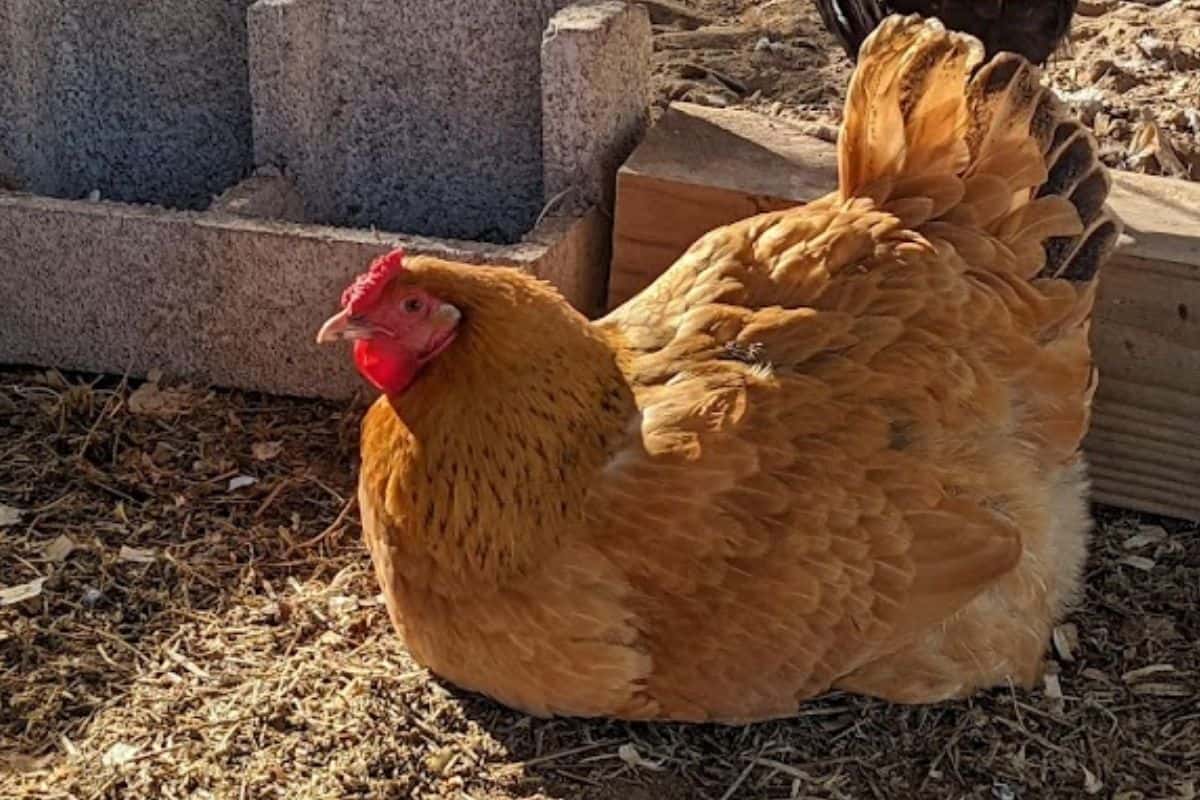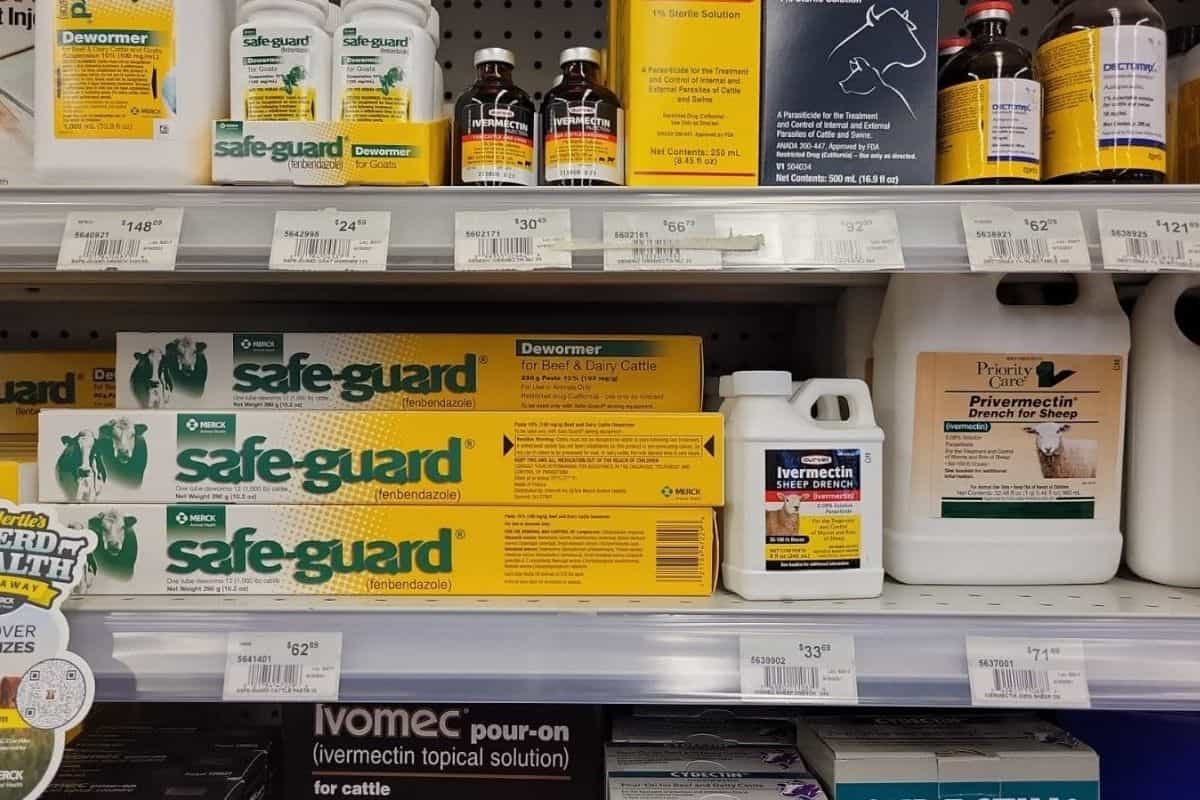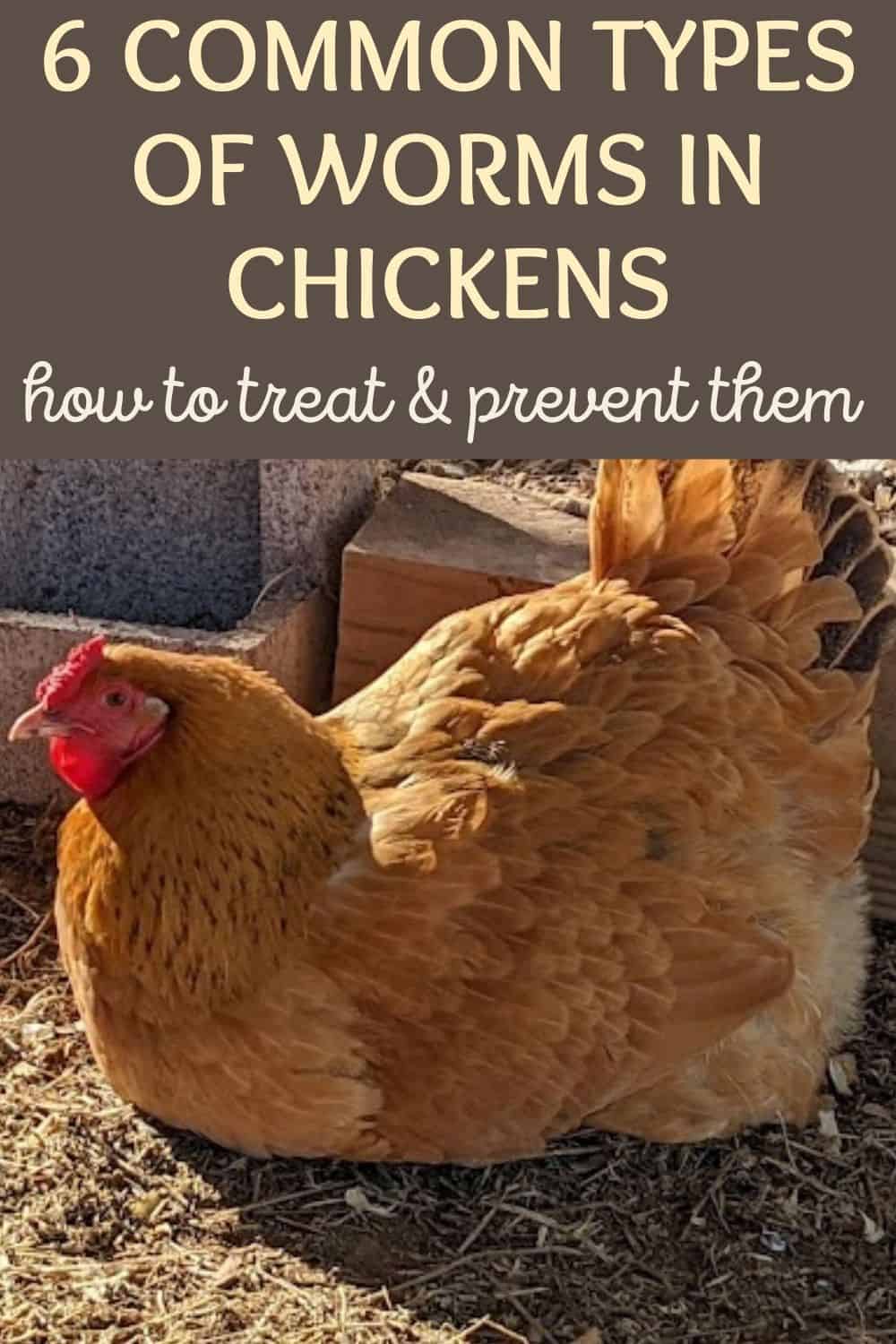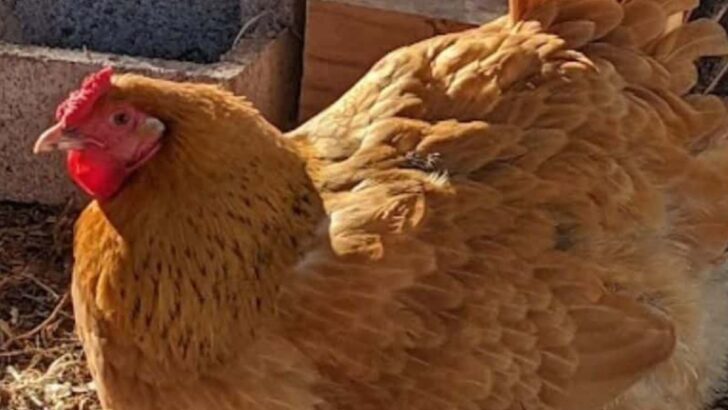Worms are a common ailment in backyard flocks. As a chicken owner, it’s scary when your babies aren’t doing well. In this article, we will discuss the 6 most common types of worms in chickens, how to detect and treat them and prevent them from coming back.

Common Types of Worms in Chickens
It’s so sad when our chickens are sick and we can’t figure out why. Let’s look at some of the most common worm types, so you can keep an eye on your chicks and make sure you detect quickly if any of them have a parasite problem.
Related: Respiratory diseases in chickens
1. Large roundworm
The large roundworm (Ascaridia galli) is the most common intestinal parasite found in chickens and lives freely in the small intestine. It is yellowish-white in appearance, quite thick, and can grow to four and a half inches long. Large roundworms are visible to the naked eye and in a bad infestation, adult worms may be seen in fecal droppings.
Large roundworms have a direct life cycle which means they transmit to other chickens when they eat feces infested with eggs. The eggs are ingested they then travel to the small intestine where they hatch and grow. It takes about a month for the worms to fully mature. Chickens will begin to shed worm eggs into their feces about five to eight weeks after the initial infection.
Large roundworms are very resilient and can survive outside in the soil for a long time without a host.
Symptoms of large roundworms will vary depending on the severity of the infestation. Chicks less than three months old are more susceptible to succumbing to an infestation.
Signs of a large roundworm infestation
- pale comb and wattles
- puffed-up feathers
- loss of weight and appetite
- diarrhea
- lethargy
You may see a hen sitting in a nest for long periods of time even though she isn’t broody.
Treatment for large roundworm
Treatment includes deworming the chicken by using liquid dewormer that is either applied topically, orally, or added to the drinking water.
The only FDA-approved wormer for poultry is Piperazine. Piperazine is not approved for use in birds producing eggs for human consumption in the United States. It is only effective against adult worms and not larvae or eggs. It can be administered orally or added to the drinking water and repeated in seven to ten days.
Other treatment options are Valbazen, Ivermectin, Safeguard, and Panacur. These treatments are all used off-label and are not specifically formulated for chickens.
While treating for a large roundworm infestation you will also want to thoroughly clean your coop, runs, and equipment. To keep worms and parasites at bay, maintain a clean environment for your birds.

2. Tapeworm
Tapeworms (cestodes) are flat worms with segmented bodies that infiltrate the intestines of the chicken. They are very common among backyard and free-ranging flocks. Unlike tapeworms in other species which may be visible to the naked eye, the tapeworm species that affects chickens is quite small and not easy to see.
Tapeworms have an indirect life cycle, they are transmitted through a host such as snails, beetles, earthworms, ants, and houseflies. Once a chicken eats one of these infected hosts the larvae will release from the host and attach themselves to the chicken’s gastrointestinal system.
Then it will make its way to the intestinal wall where it will anchor itself with its hook-like mouth. Once attached to the intestinal wall the tapeworm leaches nutrients from the bird to allow itself to grow and reproduce. Once matured it will shed its segments which contain eggs that are passed through the feces. A host will consume the eggs and the cycle then repeats.
Signs of a tapeworm infestation
Signs of a tapeworm infestation include:
- loss of appetite
- loss of weight
- lethargy
- hunched up appearance with ruffled feathers
- decreased egg-laying
- and in some more severe cases, wry neck
Younger birds are more susceptible to severe infection and could have stunted growth and even die if the infestation is too great.
How to treat tapeworm in chickens
There are a few ways to treat tapeworm in chickens. Valbazen (albendazole) can be given orally and is administered according to the bird’s weight. One dose usually does the trick, but for a severe infestation, you may want to repeat after two weeks. There is a fourteen-day egg withdrawal period when using Valbazen. Eggs should not be consumed during this time.
Safeguard or Panacur (fenbendazole) labeled for goats and horses respectively can be used to treat tapeworms in chickens. With Safeguard, you’ll want to add to the drinking water. Three milliliters per gallon for three days. Repeat after ten days.
Panacur is given orally by squeezing a pea-sized portion into their beak, repeating after ten days. Be aware if you are using a fenbendazole treatment that it can be toxic to chickens in excessive amounts. Only use as directed. There is no egg withdrawal period when using either Safeguard or Panacur.
Although it is nearly impossible to stop your chickens from eating bugs that may carry tapeworms, keeping your coop and run clean is the best method of prevention.
3. Threadworm
Threadworms (capillaria) are also referred to as hair worms or small roundworms. There are different types of threadworms and they affect different areas of the chicken.
Some types invade the crop and esophagus which causes a thickening of the mucous membranes. Other types settle into the lower intestines and cause inflammation, hemorrhaging, and a deterioration of the lining of the intestines. Threadworms are microscopic and have a tubular shape with two openings, the mouth, and the anus. The females are longer than the males.
Depending on the species of threadworm they can have a direct (like the large roundworm) or indirect (like the tapeworm) life cycle. A chicken will either ingest the threadworm through contaminated feces or by eating a host carrier. Once ingested the threadworm eggs will disperse to their infection sites depending on species. The average time it takes each species to hatch, fully develop, and start to shed eggs is between two to four weeks.
Signs of a threadworm infestation
Signs of a threadworm infestation are:
- diarrhea
- lethargy
- loss of appetite
- weight loss
- poor egg production
- anemia
Young birds under three months of age are more severely affected and have a greater risk of succumbing to an infestation.
How to treat threadworm infestation
There are a few different dewormers that can be used in the treatment of threadworms. All of them are used off-label for chickens.
Valbazen (albendazole) is administered orally depending on the weight of the chicken. For large fowl birds .5 cc/ml and for bantams .25 cc/ml. It should be repeated after two weeks. You will want to withdraw eggs during treatment and for fourteen days after.
Safeguard (fenbendazole) can be added to the drinking water at three milliliters per gallon or Panacur (fenbendazole) can be given orally, a pea-sized drop in the beak. Repeat in 10 days. You do not need to withdraw eggs when using either of these options.
Ivermectin is given orally or topically depending on which kind you use. Ivermectin injectable (labeled for cows) is given orally. For standard-sized birds give .25 milliliters by mouth and for bantams give .1 milliliters by mouth. Ivermectin pour-on (labeled for cows) is applied topically. Put the liquid into a spray bottle and give one squirt under each wing, at the base of the neck, and at the vent. Repeat after two weeks. It is recommended that you do not give away or sell eggs for seven days after treatment with Ivermectin.
As with any other worm or parasite, the best prevention is a clean, dry environment.
4. Gapeworm
Gapeworm (Syngamus trachea) is a type of roundworm that affects the chicken’s trachea by burying its head into the lining and causing the bird to yawn or gasp frequently. It is called gape or “the gapes” because the chicken constantly gapes its mouth open to take in air.
Gapeworms are large enough to be seen by the naked eye, are red in appearance, and form a Y shape where the male permanently attaches itself to the female.
The gapeworm has both a direct life and indirect life cycle like the threadworm. A chicken can become infected by ingesting feces contaminated with larvae or by eating a host insect or earthworm. Once ingested the larvae will travel to the trachea where they will attach themselves and begin to reproduce. The eggs are either coughed up or swallowed by the chicken. If swallowed they pass through the feces and contaminate the soil. It takes two to three weeks for this entire process to take place.
A chicken infected with gapeworm will stretch their neck out and open its beak to try and better breathe in air. They do this because the worms block the airway and prevent sufficient air flow. If the infestation becomes too great they could eventually die from suffocation.
Signs of gapeworm infestation
Signs of a gapeworm infestation include:
- gaping
- difficulty breathing
- head shaking
- coughing
- loss of appetite
- weight loss
Small breeds and young birds are more severely affected by gapeworm.
How to treat gapaworm
The treatments for gapeworm are the same as those for threadworm. All of them are used off-label for chickens. Valbazen (albendazole) is administered orally depending on the weight of the chicken, .5 cc/ml for large fowl and .25 cc/ml for bantams. It should be repeated after two weeks. While treating with Valbazen and for fourteen days after, eggs should be withdrawn and not eaten.
Safeguard (fenbendazole) can be added to the drinking water at three milliliters per gallon or Panacur (fenbendazole) can be given orally, a pea-sized drop in the beak. Repeat in 10 days. It is safe to continue consuming eggs during treatment with either of these options.
Ivermectin is given orally or topically depending on which kind you use. Ivermectin injectable (labeled for cows) is given orally. For standard-sized birds give .25 milliliters by mouth and for bantams give .1 milliliters by mouth. Ivermectin pour-on (labeled for cows) is applied topically. Put the liquid into a spray bottle and give one squirt under each wing, at the base of the neck, and at the vent. Repeat after two weeks. There is a recommended withdrawal period of seven days for eggs when using Ivermectin.
The best prevention is a clem, dry environment.
5. Cecal worm
A cecal worm (Heterakis gallinarum) is an internal parasite found in the ceca of a chicken. The ceca is located between the small and large intestines. It uses bacteria to break down undigested food passing from the small intestine into the large intestine. The main significance of the cecal worm is that it carries a protozoan that causes blackhead disease which mainly affects turkeys, but can sometimes affect chickens.
The cecal worm has both a direct and indirect life cycle meaning a chicken can become infected by eating contaminated soil or by consuming a host organism infested with eggs.
Cecal worm eggs can survive in the soil for up to two years without a host.
Once the cecal worm eggs enter the chicken, they travel to the upper intestine where they hatch and then relocate to the ceca. The adults then reproduce and the eggs are shed through feces, starting the cycle all over again.
Typically chickens are unaffected by the protozoan carried by the cecal worm and will show no signs of illness. Those that do become affected are often times lethargic and fail to thrive.
Turkeys, on the other hand, are greatly affected by the protozoan carried by the cecal worm, the infection is called blackhead disease. It is recommended that turkeys and chickens are not housed together to prevent infestation through the soil. Many small, backyard poultry keepers will house them together with no issues. Larger and commercial operations seem to be more affected by it.
How to treat cecal worms
The treatments for cecal worms are the same as those for threadworm and gapeworm. All of them are used off-label for chickens.
- Valbazen (albendazole) is administered orally depending on the weight of the chicken. It should be repeated after two weeks. A fourteen-day egg withdrawal is recommended when using Valbazen.
- Safeguard (fenbendazole) can be added to the drinking water at three milliliters per gallon or Panacur (fenbendazole) can be given orally, a pea-sized drop in the beak. Repeat in 10 days. No egg withdrawal is necessary.
- Ivermectin is given orally or topically depending on which kind you use. Ivermectin injectable (labeled for cows) is given orally. For standard-sized birds give .25 milliliters by mouth and for bantams give .1 milliliters by mouth. Ivermectin pour-on (labeled for cows) is applied topically. Put the liquid into a spray bottle and give one squirt under each wing, at the base of the neck, and at the vent. Repeat after two weeks. A seven-day egg withdrawal is recommended.
Keeping your chicken’s environment clean and dry will help to minimize their contact with cecal worm eggs.
6. Eye Worm
The eye worm (Oxyspirura mansoni) is a type of roundworm that affects the eye of the chicken. It is most commonly found in the southern states where the Surinam cockroach is found. It is a small, thin white worm. It will attach to the corner of the chicken’s eye under the membrane where it causes extreme discomfort and impaired sight.
The eye worm has an indirect life cycle, it is carried by the Surinam cockroach. When a chicken eats an infected cockroach, the eggs will hatch in the crop and travel to the esophagus, through the mouth, into the nasal cavity, and eventually settle in the eye. This is where it will grow to adulthood and lay its eggs in the chicken’s eye. The eggs will pass through the tear ducts, be swallowed, and pass through the feces.
Eye worm symptoms
Symptoms of an eye worm infection are:
- frequent eye scratching
- conjunctivitis
- eyelids may be stuck together
- and in severe cases, the bird may go blind
How to treat eye worm
While the recommended treatment for eye worms is Piperazine, it is not approved for use in birds producing eggs for human consumption in the United States. It is however approved for one-time use in poultry in Canada and Australia with no egg withdrawal period. Some other forms of treatment are VetRX, an herbal remedy that can be found at most commercial feed stores, and extraction by a veterinarian.
Again, the best way to avoid contamination and infestation is to keep your chickens in a clean, dry environment.
Frequently asked questions about chickens with worms
Is it safe to eat eggs from chickens with worms?
The answer is complicated. Worms do not typically affect the chicken’s egg, however, if there is a severe infestation of large roundworms it is possible for them to be found in the egg. This is very rare.
When you are treating a chicken for worms there can be a withdrawal period for eggs during and for sometime after treatment. This means that the eggs should not be consumed during this time period. You’ll need to carefully read the label or consult with a veterinarian to find out if there is a withdrawal period for the treatment you are using.
Can I use pumpkin seeds or diatomaceous earth (DE) to worm my chickens?
There have been no conclusive studies to show that either of these things is an effective dewormer. If you want to feed your chickens pumpkins or sprinkle DE in the coop and run it won’t do any harm, but just know that neither of these things will treat a worm infestation. You will need a chemical dewormer for that.
What is the best dewormer for chickens?
This will depend on what type of worm your chicken has. Not all dewormers work on all types of worms. The best course of action is to find out exactly which type of worm your chicken has and treat it accordingly.
Should I deworm my chickens on a schedule?
Chickens should only be wormed when they have an infestation. Worming on a schedule creates worm resistance. Instead of worming on a schedule, practice good flock management. This includes keeping your coop and run clean and free of excess moisture.
How can you tell if your chicken has worms?
The most common signs are lethargy, loss of appetite, reduced egg production, and weight loss. Some types of worm infestations will have distinct symptoms, such as the gapeworm which causes the chicken to gasp for air.
Can I get worms from my chickens?
The answer is no. The majority of worms found in chickens are species-specific and do not transmit to humans.
Learn everything you need to know about raising chickens



Quick Guide To Raising Backyard Chickens
Thursday 28th of July 2022
[…] 6 Common Types of Worms In Chickens: How To Prevent, Detect, And Treat […]
Scaly Leg Mites In Chickens: Symptoms, Treatment, And Prevention
Friday 11th of March 2022
[…] Other contagious chickens ailments: Common types of worms in chickens […]